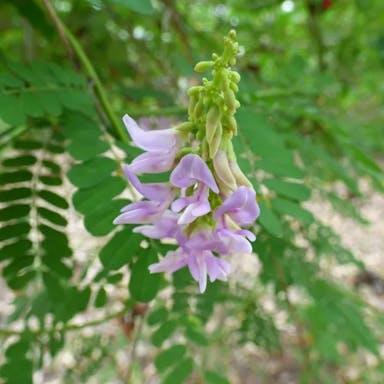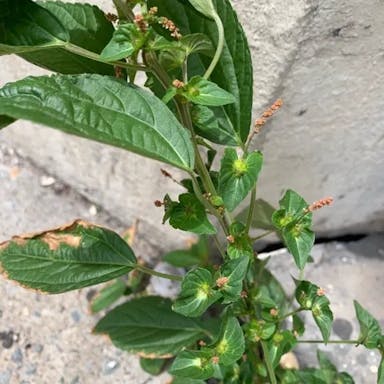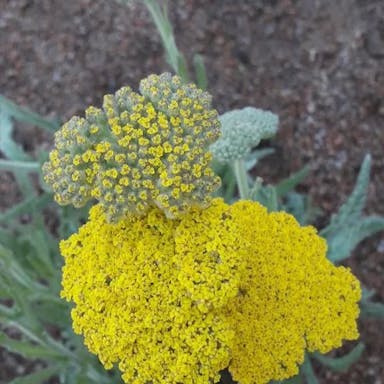The tropical perennial plant scientifically termed as Fittonia albivenis is native to the rainforests of Peru in South America. It belongs to the flowering plant family Acanthaceae and is popularly known as Mosaic plant due to the distinctive leaf veins that resemble mosaic artwork. This low-growing plant reaches a height of 6 to 12 inches, making it suitable for indoor spaces. The leaves are small and oval, typically featuring contrasting green and white or pink veins, although some cultivars have red or silver accents. While it does produce minimal white or pale pink blooms, this species is prized for its ornamental foliage. To care for this plant indoors, provide filtered sunlight, consistent moisture, and high humidity. Well-draining potting soil is recommended. With the proper growing conditions, Fittonia is relatively easy to maintain.
Mosaic-plant
- Scientific name
- Fittonia albivenis
Basic Information
- Acanthaceae Family Fittonia Genus Mosaic-plant Species
- Acanthaceae > Fittonia > Fittonia albivenis
- 75%
- The Completeness of This Encyclopedia
Please help us complete the encyclopedia, Terrarium is a encyclopedia service to be completed with everyone in the world. Currently, this page is 75% complete. For more information on how to contribute, please click here.
- Forb/herb
- Height
- 15cm ~
- Flower Color
- Leaf Color
- Anthesis
- Sunlight Exposure
Full Sun Long hours of sunlight from morning to afternoon Partial Shade A location in the shade of a tree or where either the morning or afternoon is shaded Full Shade A place where there is no direct sunlight
- Partial Shade
- Hardiness Zones
This is an indicator to know to which zone each plant can winter. Knowing the zone of each plant gives you an idea of the cold temperature resistance when grown in the ground without a roof. 2: -42.7 to -40.0 3: -39.9 to -34.4 4: -34.3 to -28.9 5: -28.8 to -23.3 6: -23.2 to -17.8 7: -17.7 to -12.2 8: -12.1 to -6.7 9: -6.6 to -1.1 10: -1.0 to 4.4 11: 4.5 to 10.0
- 11
- Cold resistance
- Poor
- Heat resistance
- Fair
- Habitat of origin
- Peru
- Growth Rate
- Normal
What is Mosaic-plant (Fittonia albivenis)?
What is Mosaic-plant (Fittonia albivenis)
Flower meaning
NO DATA
Calendar of Mosaic-plant (Fittonia albivenis)
Calendar
Mosaic-plant, is Ludwigia sedioides. It perennial native aquatic United States and south eastern. Mosaic-plant provides beautiful yellow display. Flowers small, delicate, and numerous. Create stunning mosaic like pattern surface and adds beauty to gardens, habitats. Depending on sunlight, nutrients. Also pruning helps with blooming. Overall, mosaic-plant captivating aquatic adds beauty water gardens wetland habitats.
How to grow Mosaic-plant (Fittonia albivenis)
Watering
The optimal time period and technique for irrigating the Mosaic-plant depends upon diverse influences, comprising seasonal differences and earth dampness. During the flourishing season, typically developing in spring and summer, the Mosaic-plant requests consistent irrigation to sustain ground moisture. It is advised to water the fauna every 2-3 days, ensuring the terrain is evenly damp but not waterlogged. The quantity of water required can diverge contingent on the extent of the organism and the climatic circumstances, however generally, furnishing 1-2 inches of aqua per week is sufficient. Contrastingly, during the dormant season in fall and winter, the Mosaic-plant necessitates less frequent irrigation. It is imperative to permit the terrain to dry out slightly between irrigations to prevent root decomposition. Observing the ground moisture level and adapting the irrigation frequency accordingly is crucial for the health and vitality of the Mosaic-plant.
Soil and Fertilizer
The semiaquatic plant Ludwigia sedioides flourishes when the dirt retains moisture yet drains freely. Ideal filth for it has a slightly acidic to neutral composition, with abundant organic material to hold water. To help the plants thrive, mix in a balanced commercial plant food, using roughly one tablespoon per square foot. Reapply it every month or two during the growing season of frost to frost. First test the soil to see if nutrients are lacking before fertilizing. Scatter the plant food evenly around the stems, and work it gently into the top few inches of soil. Be careful that granules do not touch and burn the leaves. With attentive watering and fertilizing, the mosaic plants will likely prosper. Monitor and amend the soil as needed so it stays hospitable for the Ludwigia.
Sunlight and Place
The plant scientifically known as Fittonia albivenis requires filtered sunlight for optimal growth. Its leaves can burn if exposed to direct sunlight for prolonged periods. Temperatures between 60 and 80 degrees Fahrenheit suit it best. In winter, situate it where it will receive bright indirect light. High humidity is also beneficial. Mist the leaves daily or place the pot on a water filled tray. Keep it away from drafty areas. During summer, filtered light prevents overheating. The ideal amount of daily sunlight is 6 to 8 hours. Lower temperatures near 55 degrees Fahrenheit are tolerable short-term. However, cooler temps long-term damage its health. Leaves and stems both need the right conditions.
Advanced Information of Mosaic-plant (Fittonia albivenis)
Pruning
Mosaic-plant grows well when regularly trimmed. Pruning helps sustain vigor and form. Removing faded or hurt leaves, encouraging new shoots, and controlling size are the reasons to prune. Preventing crowding and keeping shape also require pruning. The ideal time to prune Mosaic-plant is early spring or late winter before regrowth starts. Quick recovery and robust growth during the season result. When pruning, clean, sharp shears are key to avoid disease spread and make clean cuts. To prune Mosaic-plantc, first take off any dead or yellowed leaves and stems. Cut back long or lanky branches for a fuller, bushier look. Only remove up to one-third of the leaves at once to prevent stress. After pruning, clean up debris properly to stop diseases or pests spreading. Regular water and fertilizer will aid recovery and healthy new growth. Always research care instructions for your Mosaic-plant variety, as cultivars may need slightly different pruning.
Planting and Harvest
The plant known as Ludwigia sedioides is optimal for container gardening rather than being planted in the ground. To put the plant in a pot, first pick a pot with drain holes and fill it with a soil mix that drains well. Carefully take the plant out of its original nursery pot without damaging the roots. Put the plant in the center of the new pot and fill in around it with more soil mix, making sure the top of the plant is level with the top of the soil. After potting, water the plant thoroughly and place it somewhere with bright but indirect sunlight. When it is time to repot the plant into a slightly larger pot, follow the same steps as when originally potting it. Repotting is typically needed every 1-2 years or whenever the plant outgrows its current pot. Providing improper care can cause the plant to decline. It is important to give adequate water since the plant likes moist soil. However, overwatering can lead to root rot, so allow the top inch of soil to dry between waterings. Fertilizing on a regular schedule with balanced liquid fertilizer also promotes healthy growth. Pruning can help maintain the desired size and shape.
Propagation
The Mosaic Plant, also referred to as Ludwigia sedioides, can multiply in various ways. One technique is to gather mature seeds when ripe and put them in soil, keeping it damp but not soaked. Another is to carefully split the plant into sections with roots attached, then plant each part separately. Cuttings from stems with nodes can also generate new plants if planted in mix and given indirect light. Additionally, cut off healthy leaves and put in water until roots form before planting in soil. Using all these propagation methods together will increase the likelihood of successfully generating more plants from the original. Harvesting is unnecessary for multiplying purposes.
Pests and Diseases
The plant known scientifically as Ludwigia sedioides goes by the common name Mosaic plant. This species faces threats from insects and fungi. Sap-sucking bugs can damage its foliage. Tiny white insects fly in and attach to leaves, turning them yellow before they wither. A powdery white coating seen on above-ground parts indicates fungal disease. Too much moisture in the soil leads to decay of the root system. To protect the ornamental plant, its caretaker must be vigilant. Check routinely for pests. Remove and dispose of any affected leaves immediately. Allow air to circulate freely around the vegetation. Water only when the topsoil becomes dry. Apply natural oils or chemical solutions if infestations occur. With attentive care and prevention, the beautiful Mosaic plant will continue to thrive.
Habitat of Mosaic-plant (Fittonia albivenis)
Habitat
Toxicity of Mosaic-plant (Fittonia albivenis)
Health Benefits
- edible
- Inedible
- Toxic
- No toxicity
NO DATA
Toxic for dogs and cats
NO DATA
Q&A of Mosaic-plant (Fittonia albivenis)
- How to Create Mosaic Plant Pots?
Experts know the mosaic plant Fittonia albivenis scientifically. At stores for gardens specialized or online retailers of seeds for plants, Fittonia albivenis mosaic plant seeds can be obtained. Prepare a pot containing soil that drains the water well. On the exterior, place the seeds lightly covering with a thin stratum of soil. Ensure the soil has dampness consistently but not waterlogged. In a warm, shaded place, put the pot. Typically in two to three weeks germination takes place. The mosaic plant indirect light prefers and humid conditions, making it an ideal houseplant to remember.
0
0
- What Are Some Ideas for Mosaic Plant Stands for Outdoor Use?
Constructing mosaic containers for growing Fittonia albivenis requires several procedures. Initially, collect necessary supplies: an undecorated flowerpot, colored tiles or fragments of glass, glue, and grout. Next, fix the tiles or glass pieces on the flowerpot's exterior surface by arranging them in your preferred design. Apply a robust adhesive to attach them. After the glue has solidified, fill the gaps between the tiles or glass with grout. Wipe away any surplus grout. Finally, place the Fittonia albivenis plant in the container. Ensure the soil drains well and the light is indirect for optimal growth.
0
0
- Is there a recommended way to choose Fittonia albivenis?
The scientifically named plant Fittonia albivenis is frequently chosen as a house plant because of its pretty leaves. When picking baby plants or seeds of this plant, it's essential to think about the type. There are various types available, each possessing its own special qualities. One type is the Pink Vein type, that has green leaves with vivid pink veins running through them. This type contributes a pop of coloration to any inside area. Another variety is the White Vein type, that has green leaves with delicate white veins. This variety possesses a more subtle and stylish look. When selecting baby plants or seeds, look for healthy plants devoid of any signs of disease or pests. The leaves ought to be vibrant and free from discoloration or drooping. It is also vital to ponder the size of the plant. Smaller baby plants are simpler to establish and care for, while larger plants might need more attention. Overall, picking this plant's baby plants or seeds requires considering the type, the health of the plant, and the size of the plant.
0
0












